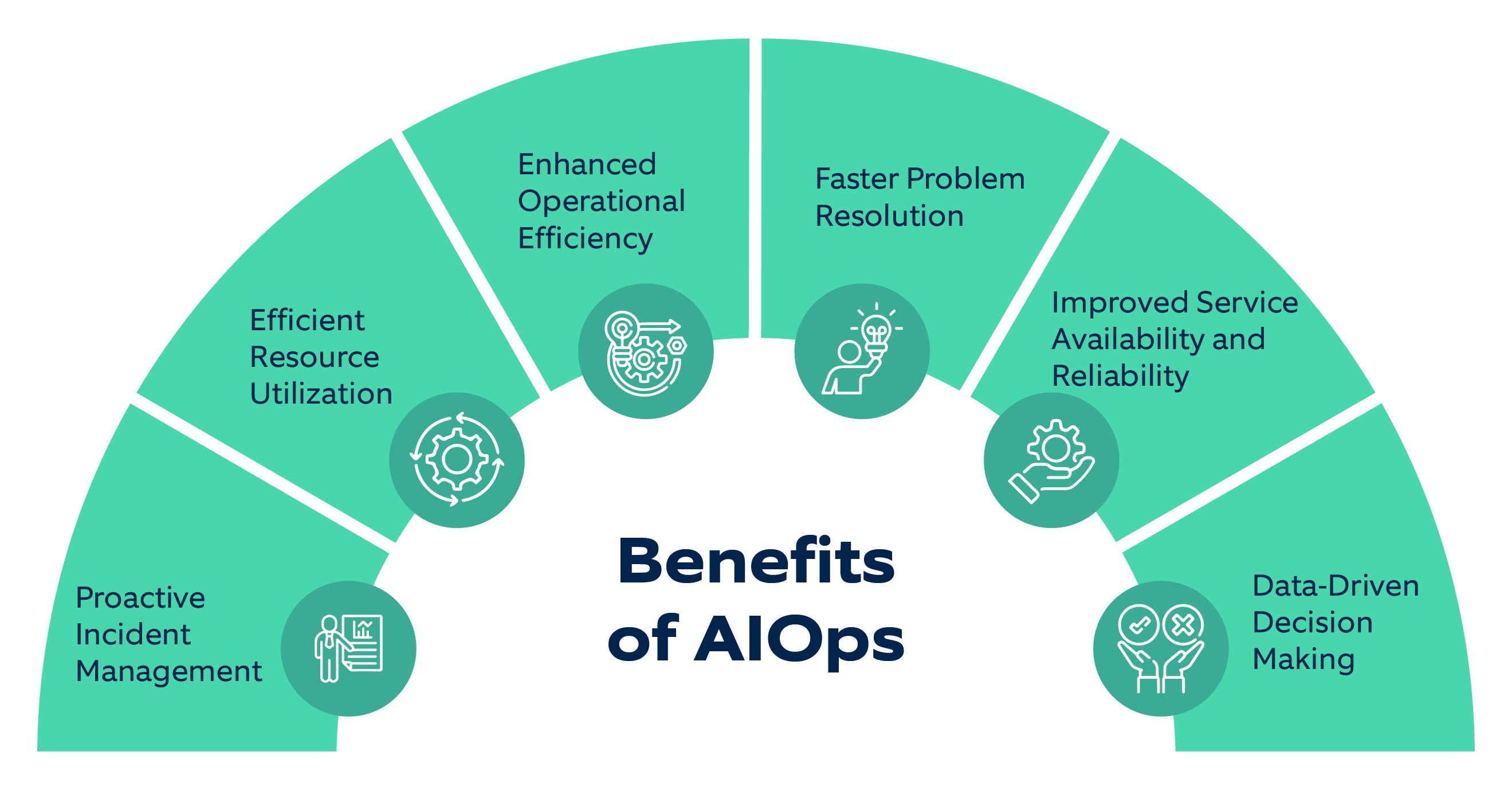Why should you be reading this article? How will it help you? This article will usher you into that realm of cutting-edge technology where Artificial Intelligence meets IT operations – that’s right, welcome to the captivating world of Artificial Intelligence for IT Operations aka AIOps!
What are the biggest challenges for that businesses are confronting today? They are grappling with the ever-mounting complexities of IT infrastructures, soaring customer expectations, and the constant quest for seamless service delivery. The conventional methods of managing IT operations have reached their limits, struggling to keep pace with the relentless challenges that arise. This is where AIOps can prove to be the perfect remedy for all these issues.
AIOps is an innovative solution that embraces the prowess of AI and machine learning. By seamlessly integrating these advanced technologies into IT operations management, AIOps empowers organizations to unlock a world of possibilities. Picture this: AI algorithms are analyzing vast data troves, data analytics reveal hidden insights, and intelligent automation is taking the reins to proactively detect and resolve issues. How cool is that!
Allow me to take you on an immersive journey into the heart of AIOps. Throughout this comprehensive blog post, we'll explore its practical applications, unravel the magic behind its underlying algorithms, assess its myriad benefits, and understand ways to ensure its successful implementation. Let’s dive in!
What is AIOps?
AIOps is a transformative approach that leverages AI, machine learning, and data analytics to enable intelligent and automated decision-making in IT operations. By integrating and analyzing vast amounts of structured and unstructured data from various sources such as logs, metrics, events, and user behaviour. AIOps empowers organizations to gain valuable insights, detect patterns, and make data-driven decisions for optimizing IT operations.
Underlying Algorithms in AIOps
There are three main underlying algorithms that power different AIOps approaches. They are not specific to their application in operations but are part of general AI / ML. However, if you want to apply them effectively as part of an AIOps approach, it is important to first understand their characteristics.
AIOps leverages anomaly detection algorithms like statistical methods (example: z-score, moving averages), clustering techniques (example: k-means, DBSCAN), and machine learning models (example: isolation forests, autoencoders) to identify deviations from normal patterns. By continuously monitoring metrics, logs, and events, these algorithms can detect unusual behaviour and raise alerts for potential incidents or performance degradation.
Additionally, AIOps employs correlation analysis techniques to identify relationships and dependencies between various data points. By analyzing event sequences, temporal patterns, and causal relationships, algorithms like correlation matrices, sequential pattern mining, and Bayesian networks help determine the root cause of incidents, thus enabling efficient RCA and incident resolution.
And finally, AIOps platforms also leverage machine learning algorithms like regression models, decision trees, random forests, and neural networks to perform predictive analytics. These algorithms analyze historical data, identify patterns, and learn from past trends to forecast future capacity requirements, application performance, and potential bottlenecks. This enables organizations to proactively plan resource allocation and optimize infrastructure to meet evolving demands.
Blog author Jatin Kumar in our "Let's talk DevOps" - video talk show on the topic of AIOps
Practical Applications of AIOps
After understanding the basic algorithms and their capabilities, the question that arises is: How can organizations utilize AIOps capabilities in their daily operations and what use cases can they support?
Here are three promising areas that AIOps covers:
- Incident Management and Automated Root Cause Analysis (RCA)
- Intelligent Alerting and Noise Reduction
- Capacity Planning and Predictive Analytics
Incident Management and Automated Root Cause Analysis (RCA)
AIOps acts as an early warning system, continuously monitoring data streams from multiple sources. By applying machine learning algorithms, it can identify anomalies, deviations, and patterns that indicate potential incidents. These incidents are then automatically correlated and analyzed to determine the root cause. AIOps platforms utilize techniques such as clustering, anomaly detection, and correlation analysis to provide accurate RCA, reducing mean time to repair (MTTR) and minimizing the impact of incidents.
Intelligent Alerting and Noise Reduction
AIOps platforms use advanced AI algorithms like supervised and unsupervised machine learning, natural language processing (NLP), and deep learning to intelligently categorize, prioritize, and route alerts. By learning from historical data and feedback from IT operations teams, AIOps platforms can reduce alert fatigue, eliminate false positives, and ensure that critical alerts reach the right teams at the right time. This helps improve incident response and resolution times.
Capacity Planning and Predictive Analytics
AIOps enables organizations to accurately forecast future demand and proactively plan resource allocation. By analyzing historical data on resource utilization, application performance, user behaviour, and external factors, AIOps platforms employ predictive analytics algorithms like time series analysis, regression, and machine learning models to forecast capacity requirements. This helps organizations optimize resource provisioning, scale infrastructure, and ensure efficient utilization, resulting in improved service delivery and cost optimization.
Benefits of AIOps

Proactive Incident Management: AIOps empowers IT teams to detect and resolve issues before they impact business operations, reducing downtime and improving service availability.
Efficient Resource Utilization: By accurately forecasting capacity requirements, AIOps enables organizations to optimize resource allocation, scale infrastructure as needed, and ensure efficient utilization, leading to cost savings.
Enhanced Operational Efficiency: AIOps automates manual processes, reduces alert noise, and provides actionable insights, enabling IT teams to focus on strategic initiatives and deliver higher-quality services.
Faster Problem Resolution: AIOps accelerates problem resolution by applying intelligent automation and correlation techniques. It can analyze diverse data sources, such as logs, metrics, and events, to identify the root cause of issues more quickly and accurately. This leads to faster incident response and resolution, minimizing the impact on business operations.
Improved Service Availability and Reliability: AIOps helps improve service availability and reliability by continuously monitoring and analyzing IT infrastructure and applications. By detecting and resolving issues proactively, it minimizes service disruptions, improves uptime, and enhances overall user experience.
Data-Driven Decision Making: AIOps provides valuable insights and actionable intelligence based on data analysis. It empowers IT teams to make informed decisions, optimize resources, and prioritize tasks based on real-time and historical data. This data-driven approach enhances decision-making capabilities and enables organizations to align IT operations with business objectives.
Considerations for Successful AIOps Implementation
It is also important to note that even though the potential benefits and use cases for AIOps are vast, we must also be mindful of many other considerations that will heavily influence a successful AIOps implementation. The following factors can lead to unfulfilled expectations or subpar performance:
- Robust Data Management: Organizations need a robust data management strategy to collect, store, clean, and process relevant data. Data quality and accessibility are crucial for accurate analysis and optimal AIOps performance.
- Collaboration and Skill Sets: Successful AIOps implementation requires collaboration between IT operations teams, data scientists, and domain experts. Effective knowledge sharing and collaboration enhance the understanding of IT environments and the development of accurate models.
- Continuous Monitoring and Iterative Improvement: AIOps systems should be continuously monitored, evaluated, and fine-tuned to adapt to changing IT environments. Regular optimization ensures accuracy, relevance, and adaptability of AIOps algorithms.
Conclusion
AIOps represents a groundbreaking leap in IT operations management, as compared to traditional IT operations in managing, planning & improving efficiency. By leveraging AI algorithms, machine learning, and data analytics, organizations can gain valuable insights, automate processes, and proactively address potential issues. AIOps empowers IT teams to become more efficient, improve service availability, optimize resource utilization, and enhance the overall customer experience. But all these benefits come with a caveat: successful AIOps implementation requires robust data management, collaboration, and continuous monitoring. By embracing AIOps, organizations can unleash the full potential of their IT operations and embrace a future where AI-powered intelligence transforms the way they deliver services.
I hope these insights will help you get started with AIOps. I'd love to hear about your experiences and your feedback or comments on this article. Please feel free to connect with me.





